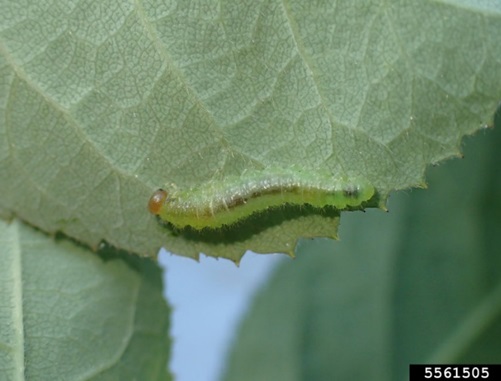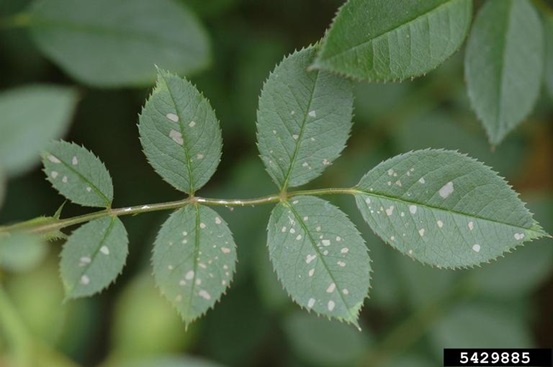How to Deal with Roseslugs
ENTFACT-467: How to Deal with Roseslugs | Download PDF
by Jonathan Larson, Extension Entomologist
University of Kentucky College of Agriculture
Fast Facts
- There are multiple species of roseslugs, but they are all immature wasps that feed on the leaves of roses They resemble small yellow-green caterpillars with red heads.
- Roseslug damage first appears in April and can continue to appear throughout the growing season. They skeletonize leaves, though they usually leave “windowpane” damage, small areas of papery leaf material that is nearly see-through.
- Roseslug control can be achieved with Spinosad or insecticidal soap applied to leaves at the start of damage. Systemic treatments of imidacloprid or dinotefuran in the spring can prevent damage from occurring.
Potential Hosts
Roseslugs are specialists on roses, though there are reports of them damaging strawberries and raspberries as well.
Symptoms and Pest Description
Roseslugs create skeletonizing damage, feeding on the soft parts of the leaf, and leaving behind the veins. When they are small, they usually leave behind a thin papery layer in the feeding area, creating a windowpane like effect. As they mature, they can chew entirely through the leaf. You can see both types of damage later in the season. The damage resembles Japanese beetle damage to rose leaves but starts earlier in the year.
Roseslugs are a type of sawfly wasp. Sawflies are stingless wasps, and their immature forms can be pests of a variety of plants. Some other famous sawflies include the pine sawflies and the white oak slug sawfly. The adult wasps look different from other wasps as they lack the traditional “wasp waist”, a constriction in the connection between the thorax and the abdomen, sawflies have a broad waist. Adult sawflies are not often noticed in the landscape.

Figure 1: An immature bristly roseslug, one of three different roseslug species All three species have reddish colored head capsules and green colored bodies. Whitney Cranshaw, Colorado State University, Bugwood.org
There are three species in the roseslug complex, the roseslug, the bristly roseslug, and the curled roseslug. In the past the roseslug was the most common, but in recent years the bristly roseslug has surpassed it. All three species have a reddish-orange head area, and their bodies are light green in color. The roseslug is smooth while the bristly roseslug has short hairs that protrude from its skin. The curled roseslug is the rarest species of the three, it has small white dots all over its body and will curl into a tight ball when threatened. They can all reach about ¾ of an inch long before pupation. Though they all superficially resemble caterpillars, we can differentiate these immature wasps from immature moths or butterflies by counting the “prolegs.” Prolegs are the small fleshy legs that occur after the main three legs on the insect’s thorax. Caterpillar prolegs have crochets (little hooks at the tip of the proleg) and they have five pairs or fewer. Sawflies have no crochets and will have five or more pairs of prolegs.

Figure 2: Early feeding by roseslugs produces spotty looking damage that upon closer inspection will be papery areas of damage. (Photo: Brian Kunkel, University of Delaware, Bugwood.org)
Life Cycle in Kentucky
Roseslug has one generation per year, curled roseslug has two generations per year, and bristly roseslugs will continue to reproduce until the first frost, resulting in multiple generations. All three species overwinter as pupae in the soil. Adults emerge in early spring and begin laying eggs on host leaves, usually on the underside. The larvae will begin feeding in May. Bristly roseslug will create continual damage until the end of the season.
Management
Spinosad and insecticidal soap can manage infestations of roseslugs. These products need to be applied directly onto the larvae, so the pest must first be located on the plant. These products are also organic. Non-organic options to treat foliage with include bifenthrin, carbaryl, permethrin, and cyfluthrin. Sometimes, roseslugs are mistaken for caterpillar pests, which could lead to them being treated with Bt, a common organic caterpillar insecticide. As these pests are wasps and not caterpillars, there will be no control using Bt.
Systemic insecticides, like dinotefuran and imidacloprid, can be applied in the spring to prevent damage from occurring. When applying these products, make sure to pull mulch away from the base of the plant and treat the soil directly.
Issued 5/22
CAUTION! Pesticide recommendations in this publication are registered for use in Kentucky, USA ONLY! The use of some products may not be legal in your state or country. Please check with your local county agent or regulatory official before using any pesticide mentioned in this publication.
Of course, ALWAYS READ AND FOLLOW LABEL DIRECTIONS FOR SAFE USE OF ANY PESTICIDE!
